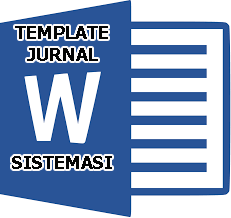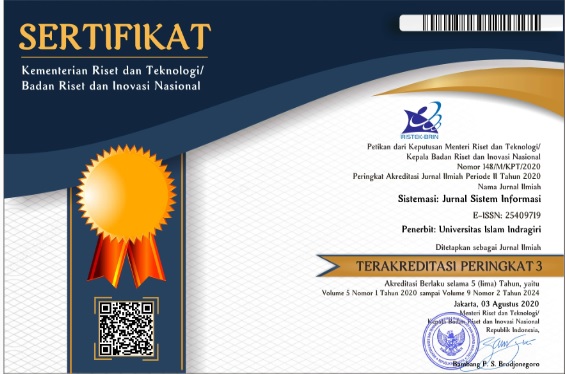Analysis of ChatGPT User Acceptance Among Gen Z using UTAUT and TPB Methods
Abstract
The study involved 96 Gen Z respondents residing in Pekanbaru, selected using a simple random sampling technique. Data were collected through the random distribution of questionnaires in various WhatsApp groups. The findings indicate that individual perceptions of control and habitual use play a crucial role in determining both the intention and actual behavior of using ChatGPT. In contrast, variables such as subjective norm, attitude toward behavior, performance expectancy, effort expectancy, hedonic motivation, and facilitating conditions did not show significant influence in this context. These results suggest that internal factors—particularly perceived behavioral control and user habits—are more dominant in influencing ChatGPT usage among Gen Z than external or social factors. Therefore, it is essential to design features that enhance user autonomy and promote the formation of positive usage habits.
Keywords
Full Text:
PDFReferences
B. D. Lund and T. Wang, “Chatting About Chatgpt: How May AI and GPT Impact Academia and Libraries?,” Library Hi Tech News, Vol. 40, No. 3, pp. 26–29, May 2023, doi: 10.1108/LHTN-01-2023-0009/FULL/XML.
T. Wu et al., “A Brief Overview of ChatGPT: The History, Status Quo and Potential Future Development,” IEEE/CAA Journal of Automatica Sinica, Vol. 10, No. 5, pp. 1122–1136, May 2023, doi: 10.1109/JAS.2023.123618.
S. Anderson and A. Lawi, “Indonesia Network Infrastructures and Workforce Adequacy to Implement Machine Learning for Large-Scale Manufacturing,” International Journal of Artificial Intelligence, Vol. 8, No. 1, pp. 1–16, 2021, doi: 10.36079/lamintang.ijai-0801.182.
A. E. Chima, N. C. Onyebuchi, and S. A. Idowu, “Promoting Digital Literacy and Social Equity in Education: Lessons From Successful Initiatives,” International Journal of Management & Entrepreneurship Research, Vol. 6, No. 3, pp. 687–696, 2024, doi: 10.51594/ijmer.v6i3.880.
T. Bates, C. Cobo, O. Mariño, and S. Wheeler, “Can Artificial Intelligence Transform Higher Education? The Aim of This Edition,” International Journal of Educational Technology in Higher Education, Vol. 17, p. 42, 2020, [Online]. Available: http://creativecommons.org/licenses/by/4.0/.
O. F. Ahmad, D. Stoyanov, and L. B. Lovat, “Barriers and Pitfalls for Artificial Intelligence in Gastroenterology: Ethical and Regulatory Issues,” Tech Innov Gastrointest Endosc, Vol. 22, No. 2, pp. 80–84, 2020, doi: 10.1016/j.tgie.2019.150636.
K. Kieslich, B. Keller, and C. Starke, “Artificial Intelligence Ethics by Design. Evaluating Public Perception on the Importance of Ethical Design Principles of Artificial Intelligence,” Big Data Soc, Vol. 9, No. 1, 2022, doi: 10.1177/20539517221092956.
T. Saputra and S. Serdianus, “Peran Artificial Intelligence ChatGPT dalam Perencanaan Pembelajaran di,” Jurnal Ilmu Sosial dan Pendidikan, Vol. 3, No. 1, pp. 1–18, 2023, doi: 10.34307/misp.v3i1.100.
F. Barreto, L. Moharkar, M. Shirodkar, V. Sarode, S. Gonsalves, and A. Johns, “Generative Artificial Intelligence: Opportunities and Challenges of Large Language Models,” Lecture Notes in Networks and Systems, Vol. 699 LNNS, pp. 545–553, 2023, doi: 10.1007/978-981-99-3177-4_41.
V. Venkatesh, M. G. Morris, G. B. Davis, and F. D. Davis, “User Acceptance of Information Technology: Toward a unified view,” MIS Q, Vol. 27, No. 3, pp. 425–478, 2003, doi: 10.2307/30036540.
I. Ajzen and M. Fishbein, “Attitude-Behavior Relations: A Theoretical Analysis and Review of Empirical Research,” Psychol Bull, Vol. 84, No. 5, pp. 888–918, Sep. 1977, doi: 10.1037/0033-2909.84.5.888.
N. Al-Qaysi, M. Al-Emran, M. A. Al-Sharafi, M. Iranmanesh, A. Ahmad, and M. A. Mahmoud, “Determinants of ChatGPT Use and its Impact on Learning Performance: An Integrated Model of BRT and TPB,” Int J Hum Comput Interact, 2025, doi: 10.1080/10447318.2024.2361210.
Y. H. S. Al-Mamary et al., “Factors Impacting Saudi Students’ Intention to Adopt Learning Management Systems using the TPB and UTAUT Integrated Model,” Journal of Science and Technology Policy Management, Vol. 15, No. 5, pp. 1110–1141, Aug. 2024, doi: 10.1108/JSTPM-04-2022-0068/FULL/XML.
B. Bouchey, J. Castek, and J. Thygeson, Multimodal Learning. 2021. doi: 10.1007/978-3-030-58948-6_3.
A. Habibi, A. Mukminin, A. Octavia, S. Wahyuni, B. K. Danibao, and Y. G. Wibowo, “ChatGPT Acceptance and use Through UTAUT and TPB: A Big Survey in Five Indonesian Universities,” Social Sciences and Humanities Open, Vol. 10, No. September, 2024, doi: 10.1016/j.ssaho.2024.101136.
A. Haris et al., Buku Panduan Penggunaan Generative AI pada Pembelajaran di Perguruan Tinggi ver1.1, Vol. 2024.
M. T. Hidayat, Q. Aini, and E. Fetrina, “Penerimaan Pengguna E-Wallet menggunakan UTAUT 2 (Studi Kasus) (User Acceptance of E-Wallet Using UTAUT 2-A Case Study),” Jurnal Nasional Teknik Elektro dan Teknologi Informasi, Vol. 9, No. 3, pp. 240–241, 2020.
A. Purwanto, M. Asbari, and T. I. Santoso, “Analisis Data Penelitian Marketing: Perbandingan Hasil,” Journal of Industrial Engineering & Management Research, Vol. 2, No. 4, pp. 216–227, 2021, [Online]. Available: https://ijospl.org/index.php/ijospl/article/view/64
M. Dimock, “Where Millennials End and Generation Z Begins | Pew Research Center,” Pew Research Center, pp. 1–7, 2019, [Online]. Available: https://www.pewresearch.org/fact-tank/2019/01/17/where-millennials-end-and-generation-z-begins/
S. Maulana, I. Khasanah, and A. Yusuf, “Analisis Penerimaan Pengguna terhadap Financial Technology Bareksa menggunakan Model UTAUT,” Jurnal Maksipreneur: Manajemen, Koperasi, dan Entrepreneurship, Vol. 12, No. 2, p. 527, Jun. 2023, doi: 10.30588/jmp.v12i2.1049.
V. Venkatesh, J. Y. L. Thong, and X. Xu, “Consumer Acceptance and use of Information Technology: Extending the Unified Theory Of Acceptance and Use Of Technology,” MIS Q, Vol. 36, No. 1, pp. 157–178, 2012, doi: 10.2307/41410412.
P. A. Pavlou and M. Fygenson, “Understanding and Predicting Electronic Commerce Adoption: An Extension of the Theory of Planned Behavior,” MIS Q, Vol. 30, No. 1, pp. 115–143, 2006, doi: 10.2307/25148720.
DOI: https://doi.org/10.32520/stmsi.v14i4.5315
Article Metrics
Abstract view : 742 timesPDF - 330 times
Refbacks
- There are currently no refbacks.

This work is licensed under a Creative Commons Attribution-ShareAlike 4.0 International License.









